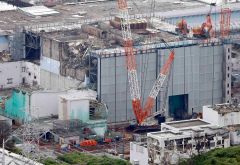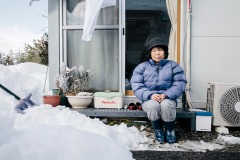by Tilman Ruff
 Fukushima-Daiichi Unit 3 reactor in July 2013
Fukushima-Daiichi Unit 3 reactor in July 2013The world’s most complex nuclear power plant disaster continues three years on, and will continue for many years hence. Uncontrolled flows of around 1,000 tons of groundwater per day into the site continue; 400 tons of water daily flows into the damaged reactor and turbine buildings where it becomes radioactively contaminated. Some is collected—more than 430,000 tons of radioactively contaminated water is now stored in about 1,000 makeshift tanks, many of which are bolted rather than welded, lack even gauges to show how full they are, and have leaked repeatedly. In one incident last month, two valves left open by mistake and one which malfunctioned led to a leak of 100 tons of water containing 230 million Bq/L of beta emitters, mostly strontium-90, 3.8 million times the maximum allowed in drinking water. Radioactivity is leaking through multiple pathways into the soil and inevitably into the ocean. During Typhoon Wipha on 16 October 2013, the 26th typhoon to hit Japan last year, levees and 12 storage tanks were reported to have overflowed. A 7.3 magnitude earthquake on 25 October 2013 was centred less than 300 km from Fukushima.
Radioactivity around the site is increasing. More than 32,000 workers have now been involved in the clean-up. Relatively lightly exposed skilled workers are in increasingly short supply, and most workers on the site are poorly trained and supported day labourers employed through multiple layers of subcontracting. There is still no national radiation register for nuclear industry workers in Japan.
By mid-February 2014, 242 spent and 22 new fuel assemblies had been transferred from the damaged Unit 4 spent fuel pool above the damaged reactor 4 to a common storage pool on the ground nearby; another 1,533 fuel assemblies are due to be transferred from Unit 4 pool by the end of this year. Decommissioning of the reactors themselves has yet to begin.
 Displaced Fukushima resident. Photo by Kristian Laemmle-Ruff
Displaced Fukushima resident. Photo by Kristian Laemmle-RuffAbout 150,000 people remain displaced, many of them still not knowing if or when they may be able to return to their former homes. Mental health and substance abuse problems, family break-up, and suicides are reportedly increased, but few firm data are available. While the average weight of Japanese schoolchildren has declined slightly since 2006, reduced play and outside exercise have resulted in rising rates of obesity in children in Fukushima. In the five years before the nuclear disaster, the proportion of obese children in Fukushima was the highest of all prefectures in no more than one grade. By 2013, Fukushima had the highest rates for six out of 13 school grades, and was between 2nd and 4th for the remaining seven grades.
In November and December 2013, government agencies promulgated statements aimed to accelerate return of displaced people to their contaminated home towns. This involves a payment—for those disadvantaged, effectively a bribe—of 90,000 yen (about US$10,000) to those returning. The government is also propsosing that levels of radiation exposure be determined by individual dosimetry. While superficially this sounds a sensible way to take account of individual and locality-related variations in exposure, the effect can be expected to be adverse as it seems intended to facilitate and encourage return to areas of relatively high environmental radioactivity, and shift the responsibility for minimising radiation exposures onto individuals and away from the government and TEPCO ensuring people are supported to live in an environment without facing excessive radiation risks.
The context for this policy is continued official denial and misinformation downplaying radiation risks. Government documents still consistently misinform the public by asserting that ionising radiation exposures of less than 100mSv have not been shown to be harmful to health. Three years on, with the acute phase of the disaster declared to be over, Japanese national policy is still based on exposures of up to 20 mSv over background levels being acceptable for the whole population, including the most vulnerable to radiation health harm—children and fetuses. This is despite the fact that 5 mSv/year is used to determine eligibility for the worker’s compensation insurance program for those who develop leukemia.
A comprehensive population register of those in significantly contaminated areas and all workers at the Fukushima Daiichi site, with early evaluation of exposures and long-term (life-time) health monitoring, recommended by IPPNW three years ago, has still not been implemented, and there seems no prospect that it will be. We also recommended that health protective and monitoring measures be applied on the basis of level of exposure to residents, irrespective of where they live. This is important because radioactive contamination extended to the neighbouring prefectures of Chiba, Gunma, Ibaraki, Miyagi and Tochigi—some areas of these provinces were contaminated to a greater degree than parts of Fukushima Prefecture. Yet disaster-related health monitoring and support is still only available for those resident in Fukushima at the time of the disaster.
The only comprehensive health monitoring being implemented is biennial ultrasound examination for Fukushima children less than 18 years old at the time of the disaster. No systematic or free comprehensive health follow-up is being undertaken, unlike the free medical examinations instituted in Tokai-mura, Ibaraki Prefecture, for residents who may have received doses higher than 1 mSv/year following a 1999 accident in a nuclear fuel fabrication plant.
The response to the ongoing Fukushima nuclear disaster and the future of nuclear power in Japan constitute a critical historic juncture for the people and environment of Japan, with global ramifications. Japan shut down all its 54 operating nuclear power reactors, producing around a third of the country’s electricity, essentially overnight in the wake of the disaster. Despite an extraordinary lack of energy conservation and efficiency programs, given Japan’s technical sophistication, different voltages used in different parts of the country, and the lack even of a national electricity grid in such a densely populated and geographically compact country, the country has managed fine in the past three years after going “cold turkey” on nuclear electricity. Industrial production has essentially been maintained, and there have been no electricity shortages through multiple hot summers. The increase in gas usage for electricity generation could be readily replaced and more by investments in energy efficiency and renewables. It has been proven abundantly that Japan does not need nuclear power. And the overwhelming majority of the population want nuclear phase-out.
Yet the intensely collusive and corrupt “nuclear village” involving industry, government and regulators responsible for the Fukushima Daiichi nuclear disaster and its mismanagement, which placed company and bureaucratic interests and minimsation of relocation and compensation costs ahead of public safety, has battened down the hatches and is attempting to carry on business largely as usual. The new Nuclear Regulatory Agency is largely made of up of old hands, and has been spending the great majority of its time on reactor re-starts rather than the urgent priority of stabilising the Fukushima Daiichi plant, and dealing with the human and environmental toll of the disaster. The “nuclear village” is aided and abetted by the government of Prime Minister Shinzo Abe, which has ditched the previous government’s commitment to nuclear phase-out, and is intent on re-starting nuclear power reactors, promoting reactor exports to all comers, and accumulating further weapons-usable separated plutonium without plausible justification.
In September 2013, PM Abe lied unashamedly in assuring the International Olympic Committee that the “situation [at the Fukushima Daiichi nuclear power plant] is under control”, and that the contaminated water is “completely contained” within a 0.3 square kilometer area. IPPNW physicians and students should ensure that we use the upcoming Tokyo Olympics to continue to focus world attention on what happens, needs to happen and is not happening in Fukushima.
Whether nuclear power will be phased out globally in the forseeable future, or continue to aggravate nuclear proliferation and the unsolved problems of radioactive waste and add to the global stockpile of ready-made potential massive radiological weapons and global radioactive disasters in-waiting depends, to a considerable extent, on what happens in Japan. The Fukushima nuclear disaster is a global health concern both because of the indiscriminate and uncontrollable spread of radioactive fallout, and the significance of what happens in Japan for the unsustainable global health danger of the massive amounts of radioactivity and fissile materials produced by nuclear power reactors.